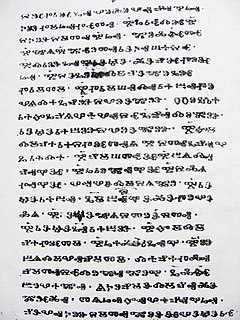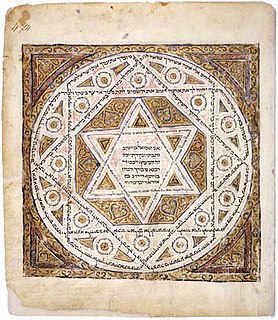
The Glagolitic script is the oldest known Slavic alphabet. It is generally agreed to have been created in the 9th century by Saint Cyril, a Byzantine monk from Thessaloniki. He and his brother, Saint Methodius, were sent by the Byzantine Emperor Michael III in 863 to Great Moravia to spread Christianity among the West Slavs in the area. The brothers decided to translate liturgical books into the Old Slavic language that was understandable to the general population, but as the words of that language could not be easily written by using either the Greek or Latin alphabets, Cyril decided to invent a new script, Glagolitic, which he based on the local dialect of the Slavic tribes from the Byzantine theme of Thessalonica.

Old Church Slavonic or Old Slavonic, also known as Old Church Slavic or Old Slavic, was the first Slavic literary language. It is also referred to as Paleo-Slavic (Paleoslavic) or Palaeo-Slavic (Palaeoslavic), not to be confused with the Proto-Slavic. It is often abbreviated to OCS.

The Corpus JurisCivilis is the modern name for a collection of fundamental works in jurisprudence, issued from 529 to 534 by order of Justinian I, Eastern Roman Emperor. It is also sometimes referred to as the Code of Justinian, although this name belongs more properly to the part titled Codex Justinianus.

Chakavian or Čakavian, , is a dialect of the Serbo-Croatian language spoken by a minority of Croats. It has a low mutual intelligibility with Shtokavian. All three main Serbo-Croatian dialects are named after their most common word for "what?", which in Čakavian is ča or ca. Chakavian is spoken mainly in the northeastern Adriatic: in Istria, Kvarner Gulf, in most Adriatic islands, and in the interior valley of Gacka, more sporadically in the Dalmatian littoral and central Croatia.

The Leningrad Codex is the oldest complete manuscript of the Hebrew Bible in Hebrew, using the Masoretic Text and Tiberian vocalization. It is dated 1008 CE according to its colophon. The Aleppo Codex, against which the Leningrad Codex was corrected, is several decades older, but parts of it have been missing since 1947, making the Leningrad Codex the oldest complete codex of the Tiberian mesorah that has survived intact to this day.

The Codex Theodosianus was a compilation of the laws of the Roman Empire under the Christian emperors since 312. A commission was established by Emperor Theodosius II and his co-emperor Valentinian III on 26 March 429 and the compilation was published by a constitution of 15 February 438. It went into force in the eastern and western parts of the empire on 1 January 439. The original text of the codex is also found in the Breviary of Alaric, promulgated on 2 February 506.

Byzantine law was essentially a continuation of Roman law with increased Christian influence. Most sources define Byzantine law as the Roman legal traditions starting after the reign of Justinian I in the 6th century and ending with the Fall of Constantinople in the 15th century.
The Codex Zographensis is an illuminated Old Church Slavonic canon manuscript. It is composed of 304 parchment folios; the first 288 are written in Glagolitic containing Gospels and organised as Tetraevangelium, and the rest written in Cyrillic containing a 13th-century synaxarium. It is dated back to the end of the 10th or beginning of the 11th century.

The Codex Marianus is an Old Church Slavonic fourfold Gospel Book written in Glagolitic script, dated to the beginning of the 11th century, which is, one of the oldest manuscript witnesses to the Old Church Slavonic language, one of the two fourfold gospels being part of the Old Church Slavonic canon.

Hval's Codex or Hval's Manuscript is a Cyrillic manuscript of 353 pages written in 1404, in Split, for Duke Hrvoje Vukčić Hrvatinić. It was illuminated by Gothic artists from the Dalmatian littoral.

The Glagolita Clozianus is a 14-folio Glagolitic Old Church Slavonic canon miscellany, written in the eleventh century.

Missale Romanum Glagolitice is a Croatian missal and incunabulum printed in 1483. It is written in Glagolitic script and is the first printed Croatian book. It is the first missal in Europe not published in Latin script. Its editio princeps, unique in the achieved typographic artistry, was published only 28 years after the Gutenberg bible's 42-lines, bears witness of high cultural attainment and maturity of Croatian Glagolites and Croatian mediaeval literature.
The Glagolitic script is older than Cyrillic script which also uses some of its letters. The exact nature of relationship between the Glagolitic and the Cyrillic scripts has been historically a matter of great study, controversy and dispute in Slavic studies, especially pertaining to the question of chronological precedence and mutual influence. Several traditional accounts on the origin of the Slavic script they describe are ambiguous in their statements of what particular script they pertain to, which is furthermore complicated by the occasional mixture of terms used for them in some sources.
The Kastav Statute is a 14th-century Glagolitic city statute of Croatian city Kastav.

The Vrbnik Statute is a 14th-century Glagolitic city statute of the Croatian city Vrbnik.
Croatian literature refers to literary works attributed to the medieval and modern culture of the Croats, Croatia and the Croatian language. Besides the modern language whose shape and orthography was standardized in the late 19th century, it also covers the oldest works produced within the modern borders of Croatia, written in Church Slavonic and Medieval Latin, as well as vernacular works written in Čakavian and Kajkavian dialects.
The Codex Vindobonensis 751, also known as the Vienna Boniface Codex, is a ninth-century codex comprising four different manuscripts, the first of which is one of the earliest remaining collections of the correspondence of Saint Boniface. The codex is held in the Austrian National Library in Vienna.


















